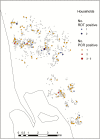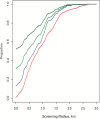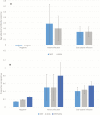Spatial Distribution of Falciparum Malaria Infections in Zanzibar: Implications for Focal Drug Administration Strategies Targeting Asymptomatic Parasite Carriers
- PMID: 28431115
- PMCID: PMC5399945
- DOI: 10.1093/cid/cix136
Spatial Distribution of Falciparum Malaria Infections in Zanzibar: Implications for Focal Drug Administration Strategies Targeting Asymptomatic Parasite Carriers
Abstract
Background: Optimal use of mass/targeted screen-and-treat or mass or focal drug administration as malaria elimination strategies remains unclear. We therefore studied spatial distribution of Plasmodium falciparum infections to compare simulated effects of these strategies on reducing the parasite reservoir in a pre-elimination setting.
Methods: P. falciparum rapid diagnostic tests (RDTs) and molecular (polymerase chain reaction [PCR]) and serological (enzyme-linked immunosorbent assay) analyses were performed on finger-prick blood samples from a population-based survey in 3 adjacent communities.
Results: Among 5278 persons screened, 13 (0.2%) were positive by RDT and 123 (2.3%) by PCR. PCR-positive individuals were scattered over the study area, but logistic regression analysis suggested a propensity of these infections to cluster around RDT-positive individuals. The odds ratios for being PCR positive was 7.4 (95% confidence interval, 2.8-19.9) for those living in the household of an RDT-positive individual and 1.64 (1.0-2.8; P = .06) for those living within <300 m, compared with >1000 m. Treating everyone within households of RDT-positive individuals (1% population) would target 13% of those who are PCR positive. Treating all living within a radius of <300 or <1000 m (14% or 58% population) would target 30% or 66% of infections, respectively. Among 4431 serologically screened individuals, 26% were seropositive. Treating everyone within seropositive households (63% population) would target 77% of PCR-positive individuals.
Conclusions: Presumptive malaria treatment seemed justified within RDT-positive households and potentially worth considering within, for example, a radius of <300 m. Serology was not discriminative enough in identifying ongoing infections for improving focal interventions in this setting but may rather be useful to detect larger transmission foci.
Keywords: asymptomatic; falciparum malaria; clustering.
© The Author 2017. Published by Oxford University Press for the Infectious Diseases Society of America.
Figures




References
MeSH terms
Substances
Grants and funding
LinkOut - more resources
Full Text Sources
Other Literature Sources

